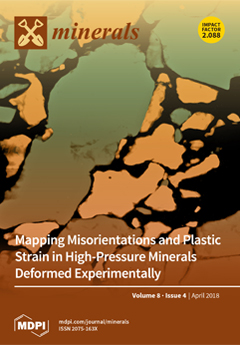The new mineral species tiberiobardiite, ideally Cu
9Al(SiO
3OH)
2(OH)
12(H
2O)
6(SO
4)
1.5·10H
2O, has been discovered in the Cretaio Cu prospect, Massa Marittima, Grosseto, Tuscany, Italy, as very rare, light green,
[...] Read more.
The new mineral species tiberiobardiite, ideally Cu
9Al(SiO
3OH)
2(OH)
12(H
2O)
6(SO
4)
1.5·10H
2O, has been discovered in the Cretaio Cu prospect, Massa Marittima, Grosseto, Tuscany, Italy, as very rare, light green, vitreous, tabular {0001}, pseudo-hexagonal crystals, up to 200 μm in size and 5 μm in thickness, associated with brochantite. Electron microprobe analysis gave (in wt %, average of 5 spot analyses): SO
3 10.37, P
2O
5 3.41, As
2O
5 0.05, SiO
2 8.13, Al
2O
3 5.54, Fe
2O
3 0.74, CuO 62.05, and ZnO 0.03, for a total of 90.32. Based on an idealized O content of 42 atoms per formula unit, assuming the presence of 16 H
2O groups and 13.5 cations (without H), the empirical formula of tiberiobardiite is (Cu
8.69Al
0.21Fe
0.10)
Σ9.00Al
1.00(Si
1.51P
0.54)
Σ2.05S
1.44O
12.53(OH)
13.47·16H
2O. The main diffraction lines, corresponding to multiple
hkl indices, are [
d in Å (relative visual intensity)]: 9.4 (s), 4.67 (s), 2.576 (m), 2.330 (m), and 2.041 (mw). The crystal structure study revealed tiberiobardiite to be trigonal, space group
R , with unit-cell parameters
a = 10.6860(4),
c = 28.3239(10) Å,
V = 2801.0(2) Å
3, and
Z = 3. The crystal structure was refined to a final
R1 = 0.060 for 1747 reflections with
Fo > 4σ (
Fo) and 99 refined parameters. Tiberiobardiite is the Si-analogue of chalcophyllite, with Si
4+ replacing As
5+ through the coupled substitution As
5+ + O
2− = Si
4+ + (OH)
−. The name tiberiobardiite honors Tiberio Bardi (b. 1960) for his contribution to the study of the mineralogy of Tuscany.
Full article





